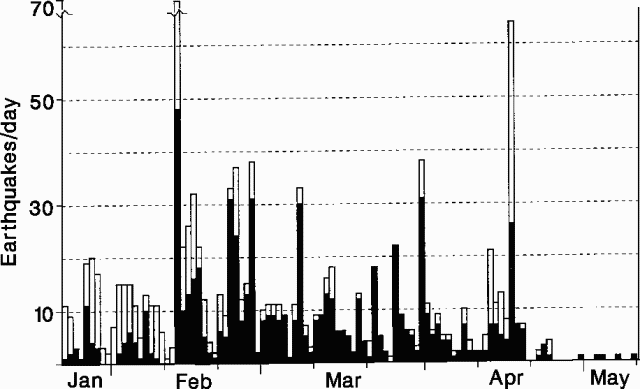Report on Submarine Volcano NNE of Iriomotejima (Japan) — April 1991

Submarine Volcano NNE of Iriomotejima
Bulletin of the Global Volcanism Network, vol. 16, no. 4 (April 1991)
Managing Editor: Lindsay McClelland.
Submarine Volcano NNE of Iriomotejima (Japan) Strong felt seismicity but no surface changes
Please cite this report as:
Global Volcanism Program, 1991. Report on Submarine Volcano NNE of Iriomotejima (Japan) (McClelland, L., ed.). Bulletin of the Global Volcanism Network, 16:4. Smithsonian Institution. https://doi.org/10.5479/si.GVP.BGVN199104-282010
Submarine Volcano NNE of Iriomotejima
Japan
24.57°N, 123.93°E; summit elev. -200 m
All times are local (unless otherwise noted)
High levels of seismicity . . . suddenly declined in late April (figure 1). A total of 670 high-frequency earthquakes were felt by the end of April, including nine of JMA intensity IV, and a M 4.3 event on 31 March. The swarm was centered on the NW coast of the island (figure 2) at 0-10 km depth (the majority at ~5 km). No surface phenomena (steaming, bubbling, or water discoloration) were found despite frequent patrolling over the island and adjacent sea area by JMSA aircraft.
 |
Figure 1. Daily number of recorded earthquakes at Iriomote-jima island, 23 January-10 May 1991. Solid columns represent felt events. Courtesy of JMA. |
 |
Figure 2. Epicenter map of earthquakes at Iriomote-jima island, 23 January-10 May 1991. A solid square marks the JMA weather station. Courtesy of JMA. |
Geological Summary. The southernmost Ryukyu Islands volcano is a shallow submarine volcano 20 km NNE of Iriomotejima island and 35 km WSW of the northern tip of the island of Ishigakishima in an area with an estimated depth of 200-300 m. A major submarine eruption on 31 October 1924 produced rhyolitic pumice rafts with an estimated volume of about 1 km3 that were carried by currents along both coasts of Japan as far north as Hokkaido. The largest pumice blocks exceeded 1 x 2 m in size, and the volume of ejecta places this poorly known eruption among the largest recorded in Japan.
Information Contacts: JMA.
